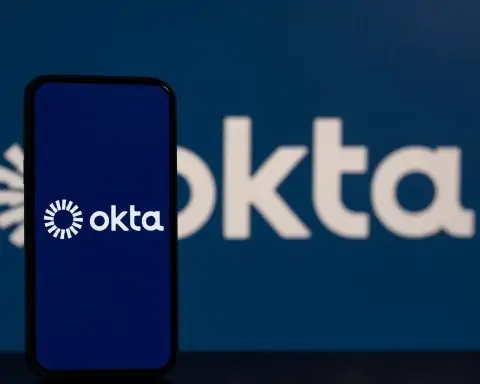Nvidia’s stock heads into Tuesday, November 18, 2025, sitting right at the center of a global tech shake‑out and increasingly loud talk of an AI bubble. The shares finished Monday around $186.60 after a drop of roughly 1.9%, and early data shows premarket trading hovering close to that level with heavy volume, as investors brace for Nvidia’s earnings on Wednesday and a long‑delayed U.S. jobs report later this week. [1]
Futures for the Nasdaq 100, S&P 500 and Dow were all lower in early Tuesday trading, extending Monday’s sell‑off that pulled major U.S. indexes below their 50‑day moving averages. Overnight, Asian markets tumbled, with tech‑heavy benchmarks in Tokyo and Seoul sliding more than 3% after Nvidia and other AI winners dragged Wall Street lower. [2]
For Nvidia (NASDAQ: NVDA), today isn’t just another pre‑earnings session. It’s a stress test for AI sentiment, liquidity, and risk appetite across global markets — and traders will be watching every tick.
1. Nvidia stock price today: where NVDA stands before the open
Latest snapshot (early U.S. premarket)
- Last regular close (Mon, Nov 17): about $186.60
- Day’s range Monday: roughly $184.32 – $189.00
- Volume: around 173–174 million shares, well above many large‑cap averages
- 52‑week range: approximately $86.62 – $212.19
- Market cap: about $4.5 trillion
[3]
In early premarket trading today, independent tape data shows Nvidia changing hands around $186–187, with more than 7.5 million shares already traded before the opening bell — above its typical premarket activity of about 6.8 million shares. [4]
Despite recent volatility, the stock is still up roughly one‑third over the past 12 months, underscoring how far it has run since the start of the AI boom. [5]
Key takeaway for traders: pricing is currently flat to slightly softer vs. Monday’s close, but the tape is very active for a premarket session — a sign that positioning into earnings is intense.
2. Why markets are on edge: AI bubble fears and a global tech sell‑off
Nvidia’s premarket action can’t be separated from the broader risk‑off mood:
- U.S. indices slid on Monday: the Dow fell about 1.2%, the S&P 500 about 0.9%, and the Nasdaq roughly 0.8%, with both the S&P and Nasdaq closing below their 50‑day moving averages for the first time since April. Nvidia alone slipped about 1.9% and was a major drag on both the S&P and Nasdaq. [6]
- Asia followed overnight: an Associated Press summary reports that Tokyo’s Nikkei and Seoul’s Kospi lost more than 3%, with chip names like Tokyo Electron and SK Hynix leading declines after Nvidia and other AI shares pulled U.S. markets lower. [7]
- Global risk assets are under pressure: a Bloomberg markets wrap notes that stocks and Bitcoin are extending losses as traders pull back from speculative areas, with the S&P 500 futures down and Bitcoin drifting toward the $90,000 mark. [8]
Layered on top of the price action is open talk of an AI bubble:
- A live blog from the Guardian highlights a warning from Google CEO Sundar Pichai that no company would be “immune” if an AI bubble burst, as valuations and capex explode across the sector. [9]
- Moneycontrol and other outlets point to big‑name investors like Michael Burry, Masayoshi Son and Peter Thiel cutting or shorting Nvidia exposure as a signal that AI exuberance may have gone too far. [10]
Bottom line: Nvidia has become the symbol of the AI trade, so any wobble in tech valuations or AI optimism is hitting NVDA harder than most.
3. Earnings preview: Wednesday is the main event
Nvidia reports fiscal Q3 2026 (company FY) results after the close on Wednesday, November 19. This is widely viewed as the week’s key event for markets. [11]
Street expectations
Across multiple data providers and previews, consensus expectations for the quarter are remarkably tight:
- Adjusted EPS: about $1.25 per share
- Revenue: roughly $54.8–55.0 billion
- Year‑over‑year growth: around +50–56% on both revenue and earnings
[12]
Analysts quoted by Kiplinger and other outlets emphasize that cloud hyperscalers have already flagged higher AI capex, so another strong print is widely anticipated. The twist: a blowout report could both validate AI demand and intensify concerns that capital spending is “limitless,” feeding bubble narratives. [13]
BofA Securities has raised its full‑year EPS forecasts for Nvidia, expecting earnings to keep climbing into 2027 and 2028, reflecting continued demand for AI GPUs such as Blackwell and future Vera Rubin generation parts. [14]
Key earnings watch‑items cited by strategists:
- Data center revenue growth (still the main engine)
- Blackwell and “Vera Rubin” AI processor adoption timelines
- Any commentary on export restrictions, China demand and supply chain
- Updated capex trends from hyperscale customers
Today’s trade is essentially a market‑wide bet on how those numbers and the guidance will land.
4. Wall Street calls: from $250 price targets to “sell candidate” technicals
The news flow on analyst opinions this morning is mixed — and that tension is exactly what makes NVDA so volatile.
Fundamental bulls are doubling down
- Stifel just raised its Nvidia price target to $250 from $212 and reiterated a Buy rating, citing CEO Jensen Huang’s recent keynote and more than $500 billion in cumulative AI infrastructure orders for Blackwell and Rubin through 2026. [15]
- A Stocktwits roundup notes multiple recent price target hikes: firms such as Evercore ISI, Wells Fargo, Oppenheimer, Morgan Stanley and Susquehanna all nudged their targets higher last week, many in the $220–265 range. [16]
- A Seeking Alpha analysis argues that worries about an “irrational AI bubble” around Nvidia are overdone, saying the stock’s valuation is still reasonable relative to its growth profile and cash generation. [17]
Short‑term technicals flash caution
At the same time, purely technical services are turning more cautious:
- StockInvest’s daily analysis pegs Monday’s close at $186.60, with support near $183.6 and resistance around $188.1, and forecasts a “fair” opening price near $186.64 today. [18]
- Based on recent volatility, it estimates a potential intraday range of about $182.8–$190.4 (roughly ±4%) and has downgraded NVDA from a “Buy” to a short‑term “Sell candidate.” [19]
In other words: fundamental analysts mostly see upside, while some technical models expect more choppiness or downside in the very near term.
5. Fresh strategic news: Arm + NVLink and Nvidia’s Africa AI push
Beyond price action, there are several meaningful business headlines on November 18 that matter for Nvidia’s long‑term story.
Arm plugs into Nvidia’s NVLink ecosystem
Arm and Nvidia announced new steps to integrate Nvidia’s NVLink Fusion interconnect into Arm’s Neoverse data‑center platform, allowing hyperscalers to pair custom Arm CPUs with Nvidia GPUs over a high‑bandwidth, low‑latency fabric. [20]
Analysts covering the move highlight a few important implications:
- Tighter Arm–Nvidia alignment in AI data centers, even as Arm also participates in rival open standards.
- More flexibility for large cloud customers to design their own Arm‑based CPUs while still being “locked in” to Nvidia’s GPU and NVLink ecosystem.
- Reinforcement of Nvidia’s position at the heart of high‑end AI infrastructure, focusing on “intelligence per watt” as AI workloads grow more power‑hungry.
For investors, this is another sign that Nvidia is not just selling chips; it is shaping the architecture of future data centers.
Cassava Technologies and Nvidia expand AI infrastructure in Africa
Separately, Cassava Technologies — backed by Nvidia — is moving to raise up to $700 million to expand and upgrade AI‑ready data centers across Africa, using Nvidia hardware to power the buildout. [21]
Key details from recent coverage and company statements:
- Cassava plans to raise up to $700 million for AI‑enabled data center expansion across the continent. [22]
- The collaboration is expected to deploy tens of thousands of Nvidia GPUs (around 12,000 in one estimate) in African data centers, aiming to make AI services more accessible to businesses, nonprofits and underserved communities. [23]
- This project aligns with a broader push to build “AI factories” in Africa, where data and compute stay on the continent rather than relying solely on overseas infrastructure. [24]
For Nvidia shareholders, this underscores long‑run demand for its data‑center products in emerging markets, even as near‑term trading focuses on U.S. macro data and AI valuations.
China export workarounds raise regulatory risk
A separate investigation covered by the Times of India and originally reported by the Wall Street Journal describes how a subsidiary of a blacklisted Chinese company managed to access Nvidia’s latest Blackwell chips via a multi‑country detour: Nvidia sold to a U.S. firm, which then shipped to an Indonesian telecom provider, ultimately feeding a Chinese AI client. [25]
The transaction appears to have stayed within the letter of U.S. law, but it highlights loopholes in U.S. export controls and has alarmed national‑security officials who worry about military uses of advanced AI chips. Nvidia’s CEO has previously warned that overly broad restrictions could hurt U.S. competitiveness, but the politics around export controls are clearly not going away. [26]
Takeaway: strategic demand for Nvidia’s chips is spreading, but so are questions about regulation, compliance and geopolitical risk — themes investors will be listening for on Wednesday’s call.
6. Sentiment check: hedge funds vs. retail traders
Big‑money investors take chips off the table
Several high‑profile investors have recently scaled back Nvidia exposure:
- A regulatory filing shows Peter Thiel’s fund, Thiel Macro, sold its entire Nvidia stake (about 538,000 shares, roughly $100 million as of late Q3), fueling AI bubble worries on Wall Street. [27]
- SoftBank’s Masayoshi Son has also unwound a multibillion‑dollar Nvidia position, and Michael Burry’s Scion Asset Management took large bearish options bets against Nvidia and Palantir earlier this year. [28]
- Analysis of hedge‑fund filings compiled in one report suggests hedge funds are roughly split, with about as many increasing Nvidia holdings as reducing them, even as the company’s market cap has pushed past $5 trillion. [29]
Together, these moves reinforce the narrative that “smart money” is nervous about AI valuations, particularly in marquee names like Nvidia.
Retail traders and TV personalities remain upbeat
On the other side of the spectrum:
- A Stocktwits poll of nearly 31,000 retail traders found that about 76% expect Nvidia to beat earnings, and prediction‑market odds are even more bullish. Retail sentiment on the platform is logged as “bullish”, with message volume about Nvidia up more than 400% in the last day. [30]
- Despite the recent pullback, Nvidia shares are still up around 39% in 2025 year‑to‑date, easily outpacing broad indexes. [31]
- On TV, Jim Cramer called Wednesday “the big night” for markets, said Nvidia sits at “the heart of the data center” and reiterated his view that there is “no AI revolution without Nvidia”, arguing that a strong report could reignite a broader tech rally. [32]
So while some star hedge‑fund managers are stepping aside, retail traders and many Wall Street analysts are still treating Nvidia as the flagship of the AI revolution.
7. Key levels and scenarios to watch for NVDA today
Given the current setup, here’s how traders are likely framing Tuesday’s session:
1. Price and volatility bands
- Reference close: $186.60
- Short‑term support: around $183–184 (where accumulated volume and recent lows cluster) [33]
- Near‑term resistance: around $188–190, a zone tested repeatedly over the past week. [34]
- Implied intraday range: technical models suggest a ±4% move (roughly $182.8–$190.4) could be “normal” volatility for today, even before earnings. [35]
- Beta: around 2.1, meaning Nvidia typically moves about twice as much as the broader market. [36]
2. Possible trading setups
These are scenarios, not predictions or recommendations:
- Bullish scenario:
If futures stabilize and AI sentiment firms, NVDA could attempt a push back toward $188–190. A steady premarket tape, positive commentary on Arm/NVLink or Africa AI expansion, or more upbeat analyst notes could support a “relief rally” ahead of earnings. [37] - Sideways / “wait‑and‑see” scenario:
With earnings and the delayed U.S. jobs report both looming, many institutions may simply sit on their hands, leaving NVDA chopping between support and resistance with elevated intraday swings but no decisive trend. [38] - Bearish scenario:
Another leg down in global tech, more headlines about AI bubble risks, or evidence of big funds de‑risking further could push NVDA through support near $183 toward the $180 area. With a P/E above 50 and a 1‑year gain north of 30%, profit‑taking can accelerate if sentiment fractures. [39]
Given Nvidia’s outsized role in major indices, moves in NVDA today can also feed back into the Nasdaq and S&P 500 themselves, amplifying market swings in both directions. [40]
8. What you should watch before the bell
If you’re following Nvidia into the open today, here’s a quick pre‑market checklist:
- Premarket price vs. Monday close
- Is NVDA holding near $186–187, breaking below $183, or making an early run at $190+?
- How does that compare to moves in Nasdaq futures and peer chip names?
- Flow and liquidity
- Premarket volume is already elevated. Continued heavy order flow can signal institutional repositioning into earnings — either hedging or building positions. [41]
- Macro headlines and AI sentiment
- Watch for fresh lines on the AI bubble debate, global AI capex, and any new comments from big tech CEOs or central bankers that might sway risk appetite. [42]
- New analyst notes or target changes
- More target hikes like Stifel’s $250 call would reinforce the bull case; any surprise downgrades or cautious notes could validate short‑term bearish technical views. [43]
- Regulatory and geopolitical news
- Developments around export controls, China workarounds, or AI infrastructure policy can quickly re‑price risk for Nvidia’s data‑center business. [44]
- Positioning data and sentiment gauges
- Keep an eye on retail sentiment polls, hedge‑fund filing analyses, and options positioning — today may be less about fundamentals and more about who is over‑ or under‑hedged before Wednesday night. [45]
Final word
Nvidia goes into November 18 trading caught between two powerful narratives:
- The bull story: dominant AI chipmaker, massive order book, expanding global partnerships (Arm NVLink, Cassava in Africa), and a long runway for AI infrastructure growth. [46]
- The bear story: stretched valuations, AI bubble fears, high‑profile investors cashing out, and a market that has grown more skittish about anything tied to expensive growth. [47]
Whichever side you believe, today’s pre‑open and intraday action is really about positioning ahead of an earnings report that could reset the entire AI narrative — for Nvidia, for big tech, and for global equity markets.
This article is for informational purposes only and does not constitute investment advice. Always do your own research or consult a licensed financial advisor before making trading or investment decisions.
References
1. stockinvest.us, 2. www.reuters.com, 3. stockinvest.us, 4. marketchameleon.com, 5. www.investing.com, 6. www.reuters.com, 7. www.wral.com, 8. www.bloomberg.com, 9. www.theguardian.com, 10. www.moneycontrol.com, 11. www.kiplinger.com, 12. www.kiplinger.com, 13. www.kiplinger.com, 14. www.kiplinger.com, 15. m.investing.com, 16. stocktwits.com, 17. seekingalpha.com, 18. stockinvest.us, 19. stockinvest.us, 20. newsroom.arm.com, 21. seekingalpha.com, 22. seekingalpha.com, 23. www.ainvest.com, 24. techcentral.co.za, 25. timesofindia.indiatimes.com, 26. timesofindia.indiatimes.com, 27. www.reuters.com, 28. www.moneycontrol.com, 29. hdfcsky.com, 30. stocktwits.com, 31. stocktwits.com, 32. www.insidermonkey.com, 33. stockinvest.us, 34. stockinvest.us, 35. stockinvest.us, 36. www.investing.com, 37. m.investing.com, 38. www.reuters.com, 39. www.investing.com, 40. www.reuters.com, 41. marketchameleon.com, 42. www.theguardian.com, 43. m.investing.com, 44. timesofindia.indiatimes.com, 45. stocktwits.com, 46. m.investing.com, 47. www.reuters.com








